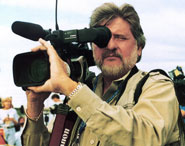 |
→ July 2004 Contents → Welcome
|
Welcome to the July issue of The Digital Journalist, the monthly online magazine for visual journalism. This month we devote our entire gallery space to photographs of President Ronald Reagan. After we included a blurb on our cover last month that we planned to do this feature, we heard from a number of our viewers that the last thing they wanted to see was more pictures of the former president, after a week of wall-to-wall coverage of the Reagan funeral. However, this president was unique in his ability to project his personality visually. For a generation of photojournalists who covered the White House, there was no better nor more meaningful photographic subject. What came out of his two terms in office were nothing less than icons of a presidency. To set the theme of our feature, we have asked our contributing editor, Dr. Patrick Cox of the Center For American History at the University of Texas, to contribute an essay that looks at the importance of this photography in a historic context. We are presenting six galleries, along with very personal caption notes, by some of the photographers whose work in the 1980s were, in many ways, defined by their coverage of the Reagan White House. Michael Evans was the official photographer to President Reagan during the first term. Pete Souza followed him in that job during the next term. He was asked to represent the family as the official photographer for the funeral; he also contributes a Dispatch in which he recounts his experiences that week. At Time magazine, a group we called "The 4 Ds," which was comprised of David Hume Kennerly, Diana Walker, Dennis Brack and myself, covered the Reagan White House. We would take turns covering a month of the administration, and very often traveled together on major trips and campaigns. We hope that these photographs and journals will shed light and some humor on covering "The Gipper." Contributing Editor Peter Howe takes note of the nation's Fourth of July celebrations, commenting on what he sees as some distressing elements happening with America's Fourth Estate, which were not exactly what our founding fathers had in mind. Our Dispatches contributors, Spencer Platt and Monica Almeida, also weigh in with their thoughts and photos from the Reagan funeral week, including Pete Souza's diary as the official family photographer. From Baghdad, Samir Mizban recounts what it is like to be an Iraqi photojournalist these days, with a gallery of "normal" Iraqis. Also, Sherrlyn Borkgren returns to Dispatches with a portrait gallery of the soldiers she covers. Our new feature, The Platypus Theatre, is getting tremendous response from viewers around the world, as we present original short films shot by graduates of our Platypus Workshops. This month, Gail Fisher of the Los Angeles Times contributes her 40-minute documentary, "Crashing Hard Into Adulthood," a gritty look at foster children on the streets of L.A. This project, which took over a year to shoot, was featured as a still photo essay in the newspaper, and as a three-part series on ABC's "Nightline." This is her personal cut of the project, which she edited with Rolf Behrens. You will note that we are presenting this film in three parts, which allows for faster download. We especially want to thank Canon Video for sponsoring these films, which actually allows us to pay something to the filmmakers. Evan Nisselson has been a regular contributor to these pages, writing about technology and how new innovations are changing photojournalism. This month he outlines some of the big problems that need to be addressed in our changing marketplace. We welcome back an old friend, Roger Williams -- or, as we call him, "Radio Roger" -- who takes a look at some of the new emergency radio services which may be of special interest to our newspaper photographers. In our columns, Jim Colburn is starting a new life, and a new series of columns from this new home in Nebraska, as a picture editor of the Lincoln Journal Star. He will call these columns, Jim Colburn in Central America. Please send him your e-mail comments so he doesn't feel as though he has fallen off the globe, after leaving his job as a Time picture editor in Washington, D.C. Also, Roger Richards is back with a new View From the Photo Desk, Terry Heaton with another TV in a Postmodern World column, Bill Pierce with Nuts and Bolts and Mark Loundy with Common Cents. The July ASSIGNMENT SHEET has two entries. The first, by Nashville freelancer Susan Adcock, is entitled, "Little Spiral Notebook." Susan Adcock is no stranger to the ever-present headshot. But her delightful journal explains how she recorded all the names in ... well, of course ... her little spiral notebook. And the memories of these people remain with her, thanks to her notations. Retired Newsday staff photographer Dick Kraus brings us Chapter Two of his "D-Day Revisited" in which he describes the trials and tribulations of his coverage and how it almost ended abruptly in the Frankfurt, Germany, railroad station. If you missed Chapter One, there is an archived version available on the ASSIGNMENT SHEET Contents page. Finally, Beverly Spicer dishes up a tantalizing blend of whimsy, starting with the full video rendition of his song, "Let the Eagle Soar," by none other than Attorney General John Ashcroft. It speaks (or sings) for itself in our E-Bit feature. We hope you enjoy this issue. Next month, we will be reporting from the Democratic National Convention in Boston. Until then, have a great summer.
Dirck Halstead
|
